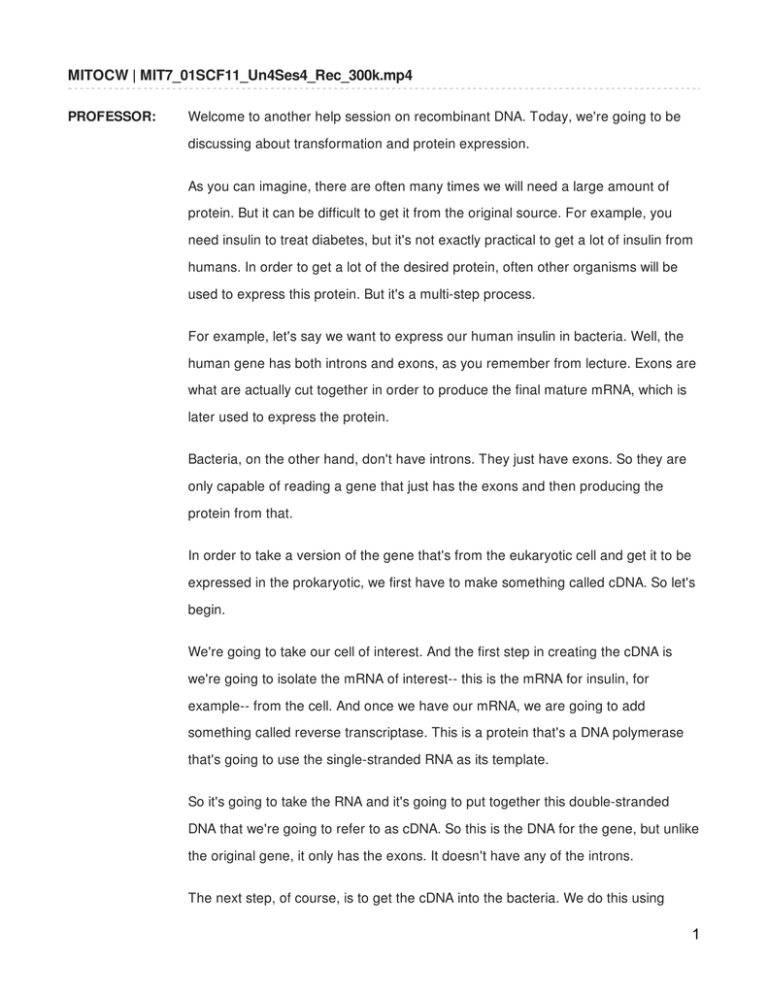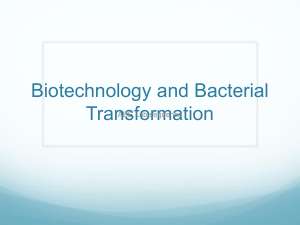MITOCW | MIT7_01SCF11_Un4Ses4_Rec_300k.mp4
advertisement

MITOCW | MIT7_01SCF11_Un4Ses4_Rec_300k.mp4 PROFESSOR: Welcome to another help session on recombinant DNA. Today, we're going to be discussing about transformation and protein expression. As you can imagine, there are often many times we will need a large amount of protein. But it can be difficult to get it from the original source. For example, you need insulin to treat diabetes, but it's not exactly practical to get a lot of insulin from humans. In order to get a lot of the desired protein, often other organisms will be used to express this protein. But it's a multi-step process. For example, let's say we want to express our human insulin in bacteria. Well, the human gene has both introns and exons, as you remember from lecture. Exons are what are actually cut together in order to produce the final mature mRNA, which is later used to express the protein. Bacteria, on the other hand, don't have introns. They just have exons. So they are only capable of reading a gene that just has the exons and then producing the protein from that. In order to take a version of the gene that's from the eukaryotic cell and get it to be expressed in the prokaryotic, we first have to make something called cDNA. So let's begin. We're going to take our cell of interest. And the first step in creating the cDNA is we're going to isolate the mRNA of interest-- this is the mRNA for insulin, for example-- from the cell. And once we have our mRNA, we are going to add something called reverse transcriptase. This is a protein that's a DNA polymerase that's going to use the single-stranded RNA as its template. So it's going to take the RNA and it's going to put together this double-stranded DNA that we're going to refer to as cDNA. So this is the DNA for the gene, but unlike the original gene, it only has the exons. It doesn't have any of the introns. The next step, of course, is to get the cDNA into the bacteria. We do this using 1 something called a vector. The vector is just a means of getting DNA into a cell. One common type of vector is a plasmid. The plasmid is a circular piece of DNA that the bacteria can then take up and read. The way we're going to get our cDNA into this plasmid is through the use of restriction enzymes. As you remember from our previous help session, restriction enzymes can cut up DNA and create these overhang of the nucleotides. So we're going to cut up the cDNA, and we're going to cut up the plasmid, and they're going to have overhangs that are complementary. This means that when we add the cDNA to the plasmids, they're going to hybridize, and then we can add DNA ligase. We add DNA ligase, it will create a phosphodiester bond between the cDNA and the plasmid vectors. And finally we'll get the cDNA inserted into our plasmid. The next step, of course, is getting the plasmid into the bacteria in order for the protein to be expressed. There are multiple, different ways to do this. One common way is called heat shock. What happens is that the bacteria is heated up and then cooled rapidly, and this creates lots of little holes in the membrane, which allow the plasma to get into the cell. Once you have the plasmid in the bacteria, your job is pretty much done. Now the bacteria will naturally express this protein, so you can grow up the bacteria in large quantities and get a lot of the protein of interest. Referring back briefly to the vector, there are several parts that are important for it to have. We're going to need to have the origin of replication, the promoter, and the selection marker. The origin of replication initiation, or ORI, is necessary if we want the bacteria to produce more copies of this plasmid. So once the plasmid gets into the bacteria, if we don't have an ORI, as the bacteria grows and reproduces, none of the daughter cells will have this plasmid. We'll have to continually transform them. However if it has the ORI, as a bacteria grows and reproduces, it will also replicate this plasmid. 2 Another very important thing to have is the promoter. The promoter is a section of DNA which signals for the RNA polymerase to bind. The RNA's polymerase will bind to the promoter, and then will proceed down the DNA on the plasmid to read the actual gene and transcribe it. So the mRNA, which then ultimately can be made into protein. Finally, you need a selection marker. Now as we talked about earlier, when you heat shock the bacteria, the plasmid will get taken up. However, not all the bacteria might take up some of the plasmid. In order to get rid of the unwanted bacteria, the bacteria that doesn't have the plasmid, we're going to use selection marker. A very common selection marker for bacteria is antibiotic resistance. For example, if the plasmid provides ampicillin resistance, then this means that any bacteria that takes up the plasmid will be resistant to ampicillin. The bacteria that don't will still be vulnerable to it. So you could plate all of your bacteria on a plate containing ampicillin, and the ones that have the plasmid will survive. The ones that don't have the plasmid will perish. So let's go once more to the original example and discuss about what we're going to need for our vector. So again, we want to express human insulin in the bacterial system. There are six possibilities for what we can need on our vector. You can need the bacterial ORI, the human ORI, the bacterial promoter, the human promoter, the bacterial selection marker, the human selection marker. Pause for a minute. Give you a chance to decide what you think the vector needs, and then we'll go over it together. OK. Does it need a bacterial ORI? Yes. If we want to grow up a large amount of insulin, we're going to put the plasmid in the bacteria. The bacteria needs to create more of this plasmid. Does it need human ORI? No, we're not actually assorting the plasmid into a human cell. So the human cell is never going to need to create more of them. Just the bacterial cell. 3 What about a bacterial promoter? Yes. Even though it's a human gene, the promoter has to be for the bacteria. Because it's going to be the bacterial RNA polymerase that will bind to the promoter, and ultimately make the mRNA from the cDNA. What about a human promoter? No, we don't need a human promoter because the human RNA polymerase won't be involved. Again, this is only going to be in the bacterial cells. It's not going to be in the human cell, so it doesn't need a human promoter. And finally for the selection markers, once again, we only need the bacterial selection marker, not the human selection marker. We're not dealing with full human cells at this point. We're just dealing with a plasmid, so we only need to select for bacteria cells that have the plasmid of interest. This has been another help section on recombinant DNA. Thank you for your time. 4







